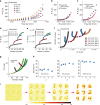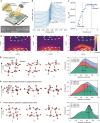Perovskite neural trees
- PMID: 32382036
- PMCID: PMC7206050
- DOI: 10.1038/s41467-020-16105-y
Perovskite neural trees
Abstract
Trees are used by animals, humans and machines to classify information and make decisions. Natural tree structures displayed by synapses of the brain involves potentiation and depression capable of branching and is essential for survival and learning. Demonstration of such features in synthetic matter is challenging due to the need to host a complex energy landscape capable of learning, memory and electrical interrogation. We report experimental realization of tree-like conductance states at room temperature in strongly correlated perovskite nickelates by modulating proton distribution under high speed electric pulses. This demonstration represents physical realization of ultrametric trees, a concept from number theory applied to the study of spin glasses in physics that inspired early neural network theory dating almost forty years ago. We apply the tree-like memory features in spiking neural networks to demonstrate high fidelity object recognition, and in future can open new directions for neuromorphic computing and artificial intelligence.
Conflict of interest statement
The authors declare no competing interests.
Figures



References
-
- Burr GW, et al. Neuromorphic computing using non-volatile memory. Adv. Phys. X. 2017;2:89–124.
-
- Wang Y, et al. Mott-transition-based RRAM. Mater. Today. 2019;28:63–80. doi: 10.1016/j.mattod.2019.06.006. - DOI
-
- Zhou Y, Ramanathan S. Mott memory and neuromorphic devices. Proc. IEEE. 2015;103:1289–1310. doi: 10.1109/JPROC.2015.2431914. - DOI
-
- Andrews JL, Santos DA, Meyyappan M, Williams RS, Banerjee S. Building brain-inspired logic circuits from dynamically switchable transition-metal oxides. Trends Chem. 2019;1:711–726. doi: 10.1016/j.trechm.2019.07.005. - DOI
Publication types
LinkOut - more resources
Full Text Sources

